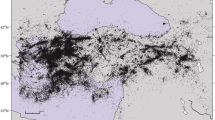Abstract
This article presents the results of applying the method of the minimum area of alarm to the complex forecasting of earthquakes based on data of different types. Point fields of earthquake epicenters and time series of displacements of the earth’s surface, measured using GPS, were used for the prediction. Testing was carried out for earthquakes with a hypocenter depth of up to 60 km for two regions with different seismotectonics: Japan, the forecast time interval from 2016 to 2020, magnitudes \(m \ge 6\); California, the forecast time interval from 2013 to 2020, magnitude \(m \ge 5.5\). Testing has shown the effectiveness of systematic earthquake forecasting using seismological and space geodesy data in combination.
This research was partially funded by Russian Foundation for Basic Research grant number 20-07-00445.
Access this chapter
Tax calculation will be finalised at checkout
Purchases are for personal use only
Similar content being viewed by others
References
Barnhart, W.D., Hayes, G.P., Wald, D.J.: Global earthquake response with imaging geodesy: recent examples from the USGS NEIC. Remote Sens. 11(11), 1357 (2019)
Bishop, C.M.: Pattern Recognition and Machine Learning. Springer, Heidelberg (2006)
Blewitt, G., Hammond, W.C., Kreemer, C.: Harnessing the GPS data explosion for interdisciplinary science. Eos 99(10.1029) (2018)
Dobrovolsky, I., Zubkov, S., Miachkin, V.: Estimation of the size of earthquake preparation zones. Pure Appl. Geophys. 117(5), 1025–1044 (1979)
Garagash, I., Bondur, V., Gokhberg, M., Steblov, G.: Three-year experience of the fortnight forecast of seismicity in Southern California on the basis of geomechanical model and the seismic data. In: AGU Fall Meeting Abstracts, vol. 2011, pp. NH23A-1535 (2011)
Geller, R.J., Jackson, D.D., Kagan, Y.Y., Mulargia, F.: Earthquakes cannot be predicted. Science 275(5306), 1616 (1997)
Gitis, V., Derendyaev, A.: The method of the minimum area of alarm for earthquake magnitude prediction. Front. Earth Sci. 8, 482 (2020)
Gitis, V.G., Derendyaev, A.B.: Machine learning methods for seismic hazards forecast. Geosciences 9(7), 308 (2019)
Gufeld, I.L., Matveeva, M.I., Novoselov, O.N.: Why we cannot predict strong earthquakes in the earth’s crust. Geodyn. Tectonophys. 2(4), 378–415 (2015)
Guomin, Z., Zhaocheng, Z.: The study of multidisciplinary earthquake prediction in China. J. Earthq. Predction Res. 1(1), 71–85 (1992)
Kanamori, H.: The nature of seismicity patterns before large earthquakes (1981)
Keilis-Borok, V., Soloviev, A.A.: Nonlinear Dynamics of the Lithosphere and Earthquake Prediction. Springer, Heidelberg (2013)
Khan, S.S., Madden, M.G.: A survey of recent trends in one class classification. In: Coyle, L., Freyne, J. (eds.) AICS 2009. LNCS (LNAI), vol. 6206, pp. 188–197. Springer, Heidelberg (2010). https://doi.org/10.1007/978-3-642-17080-5_21
King, C.Y.: Gas geochemistry applied to earthquake prediction: an overview. J. Geophys. Res. Solid Earth 91(B12), 12269–12281 (1986)
Koronovsky, N., Naimark, A.: Earthquake prediction: is it a practicable scientific perspective or a challenge to science? Mosc. Univ. Geol. Bull. 64(1), 10–20 (2009)
Kossobokov, V.: User manual for M8. In: Healy, J.H., Keilis-Borok, V.I., Lee, W.H.K. (eds.) Algorithms for Earthquake Statistics and Prediction, vol. 6, pp. 167–222 (1997)
Kotsiantis, S.B., Zaharakis, I., Pintelas, P.: Supervised machine learning: a review of classification techniques. Emerg. Artif. Intell. Appl. Comput. Eng. 160(1), 3–24 (2007)
Lighthill, J.: A Critical Review of VAN: Earthquake Prediction from Seismic Electrical Signals. World Scientific (1996)
Lobkovsky, L., Vladimirova, I., Gabsatarov, Y.V., Steblov, G.: Seismotectonic deformations related to the 2011 Tohoku earthquake at different stages of the seismic cycle, based on satellite geodetic observations. Doklady Earth Sci. 481, 1060–1065 (2018)
Mogi, K.: Two kinds of seismic gaps. Pure Appl. Geophys. 117(6), 1172–1186 (1979)
Obara, K., Kasahara, K., Hori, S., Okada, Y.: A densely distributed high-sensitivity seismograph network in Japan: Hi-net by national research institute for earth science and disasterprevention. Rev. Sci. Instrum. 76(2), 021301 (2005)
Okada, Y., et al.: Recent progress of seismic observation networks in Japan-Hi-net, F-net, K-net and KiK-net. Earth Planets Space 56(8), xv–xxviii (2004)
Rhoades, D.A.: Application of the EEPAS model to forecasting earthquakes of moderate magnitude in southern California. Seismol. Res. Lett. 78(1), 110–115 (2007)
Rhoades, D.A.: Mixture models for improved earthquake forecasting with short-to-medium time horizons. Bull. Seismol. Soc. Am. 103(4), 2203–2215 (2013)
Shebalin, P.N., Narteau, C., Zechar, J.D., Holschneider, M.: Combining earthquake forecasts using differential probability gains. Earth Planets Space 66(1), 1–14 (2014). https://doi.org/10.1186/1880-5981-66-37
Sobolev, G.: Principles of earthquake prediction (1993)
Sobolev, G., Ponomarev, A.: Earthquake Physics and Precursors. Publishing House Nauka, Moscow (2003)
Zadeh, L.A.: Fuzzy logic. Computer 21(4), 83–93 (1988)
Zavyalov, A.: Intermediate Term Earthquake Prediction. Nauka, Moscow (2006)
Zhang, L.Y., Mao, X.B., Lu, A.H.: Experimental study of the mechanical properties of rocks at high temperature. Sci. China Ser. E 52(3), 641–646 (2009)
Author information
Authors and Affiliations
Editor information
Editors and Affiliations
Rights and permissions
Copyright information
© 2021 Springer Nature Switzerland AG
About this paper
Cite this paper
Gitis, V.G., Derendyaev, A.B., Petrov, K.N. (2021). Earthquake Prediction Based on Combined Seismic and GPS Monitoring Data. In: Gervasi, O., et al. Computational Science and Its Applications – ICCSA 2021. ICCSA 2021. Lecture Notes in Computer Science(), vol 12954. Springer, Cham. https://doi.org/10.1007/978-3-030-86979-3_42
Download citation
DOI: https://doi.org/10.1007/978-3-030-86979-3_42
Published:
Publisher Name: Springer, Cham
Print ISBN: 978-3-030-86978-6
Online ISBN: 978-3-030-86979-3
eBook Packages: Computer ScienceComputer Science (R0)




